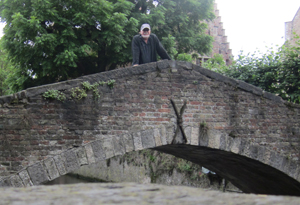in a wood, and I--
I took the one
less traveled by,
And that has made all the difference.
Travel Index:
Europe March 31 - April 20, 2015
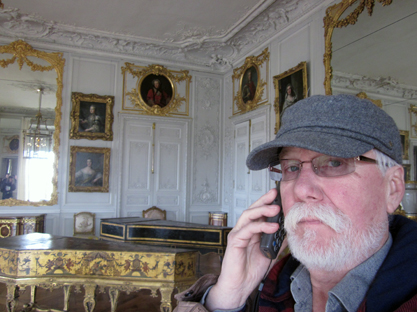 Day 2: Versailles! I took the long train (2 hours); stood with thousands in
line to get in (1.5+ hours); walked 7 hours through the palace, the grand
trianon, and the little trianon where Marie Antoionette played at
shepherdess. In the palace the thousands all seemed to have their cameras
and devises above their heads obscuring any 17th and 18th Century ambiance
you'd wish to enjoy. But the wind and chill kept them out of the gardens.
While the fountains weren't "alive" the landscape was breathtaking.
Day 2: Versailles! I took the long train (2 hours); stood with thousands in
line to get in (1.5+ hours); walked 7 hours through the palace, the grand
trianon, and the little trianon where Marie Antoionette played at
shepherdess. In the palace the thousands all seemed to have their cameras
and devises above their heads obscuring any 17th and 18th Century ambiance
you'd wish to enjoy. But the wind and chill kept them out of the gardens.
While the fountains weren't "alive" the landscape was breathtaking.
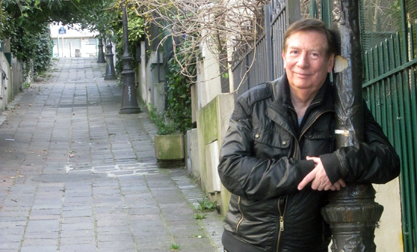 Day 3: My dinner with Andre... It was a 1981 movie that featured two guys
talking about the meaning of life. My dinner with Andre went from noon to
p.m. We started with a typical French meal at his house: a bottle of proseco
with appetizer, a bottle of Saint Veran and coquille Saint Jacques with
tomatoes provençal, fromage (cheese) au lait cru (brebis basque, mansterre,
roquefort) two special desserts
from Laurent Duchène and coffee and apéritives. Four hours later it was time
for an expedition to odd corners of Paris, the hidden Orthodox Church of
Saint-Serge where I lit a candle for positive outcome of his medical tests
tomorrow (rare disease) and the Parc Buttes Chaumont. Then more walking
ending with dinner (!) at the Table de Botzaris (seating of about 20,
traditional French menu: Dos de cabillaud rôti aux pissenlits blancs /
bouillon à la citronnelle/ légumes croquants) Perfectly done; perfect
resolution of the day.
Day 3: My dinner with Andre... It was a 1981 movie that featured two guys
talking about the meaning of life. My dinner with Andre went from noon to
p.m. We started with a typical French meal at his house: a bottle of proseco
with appetizer, a bottle of Saint Veran and coquille Saint Jacques with
tomatoes provençal, fromage (cheese) au lait cru (brebis basque, mansterre,
roquefort) two special desserts
from Laurent Duchène and coffee and apéritives. Four hours later it was time
for an expedition to odd corners of Paris, the hidden Orthodox Church of
Saint-Serge where I lit a candle for positive outcome of his medical tests
tomorrow (rare disease) and the Parc Buttes Chaumont. Then more walking
ending with dinner (!) at the Table de Botzaris (seating of about 20,
traditional French menu: Dos de cabillaud rôti aux pissenlits blancs /
bouillon à la citronnelle/ légumes croquants) Perfectly done; perfect
resolution of the day.
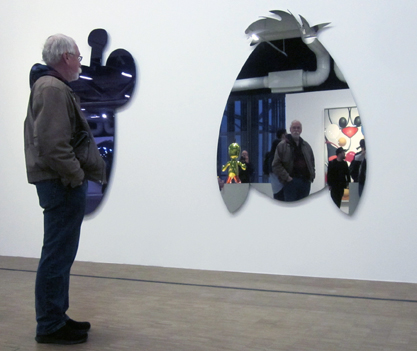 Day 4: It was another dark and damp day and I stood in line 45 minutes at
the Grande Palais to get into an amazing collection of over 50 Vélasquez
paintings from world collections, accompanied by over 100 more
contemporaries. The Rokeby Venus (also known as Venus at her Mirror, c 1651)
by Vélasquez is an extremely rare (Spanish) nude. Then onto Lumière!
dedicated to the history of inventors Louis and Auguste Lumière who
developed cinematography around 1900. As it was still "misting" I went to
the Centre Pompidou and its modern art since 1980. As I wndered, I thought
there was some I liked, some I didn't. But I thought the same of Vélasquez
several hundred years before! Jeff Coons was an eye-opner I finished off
with Atelier Brancusi, Constantin Brancusi's workshop display of art.
Day 4: It was another dark and damp day and I stood in line 45 minutes at
the Grande Palais to get into an amazing collection of over 50 Vélasquez
paintings from world collections, accompanied by over 100 more
contemporaries. The Rokeby Venus (also known as Venus at her Mirror, c 1651)
by Vélasquez is an extremely rare (Spanish) nude. Then onto Lumière!
dedicated to the history of inventors Louis and Auguste Lumière who
developed cinematography around 1900. As it was still "misting" I went to
the Centre Pompidou and its modern art since 1980. As I wndered, I thought
there was some I liked, some I didn't. But I thought the same of Vélasquez
several hundred years before! Jeff Coons was an eye-opner I finished off
with Atelier Brancusi, Constantin Brancusi's workshop display of art.
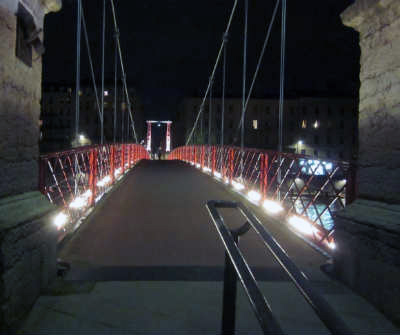 Day 5: tourism check in; river walk; cross walk: it was a travel day with
the high speed TGV train to Lyon, here for a week. Lyon has two rivers, the
Rhône & Saône, and I have an efficiency on a barge. The city is "ancient"
and reminds me of Prague and St. Paul. I checked on my event bookings at the
tourism office next to the cathedral. They had their version of a "cross
walk" through the city's (2nd largest in France) downtown. Since I have been
doing the West 7th one, and since Pastor Walt wanted info, I walked half of
it only because I couldn't find it--and seemed to be immersed in the
Algerian quarter. So I checked out the bridges and found a nice Belgian beer
and let the walk come to me--which it did.
Day 5: tourism check in; river walk; cross walk: it was a travel day with
the high speed TGV train to Lyon, here for a week. Lyon has two rivers, the
Rhône & Saône, and I have an efficiency on a barge. The city is "ancient"
and reminds me of Prague and St. Paul. I checked on my event bookings at the
tourism office next to the cathedral. They had their version of a "cross
walk" through the city's (2nd largest in France) downtown. Since I have been
doing the West 7th one, and since Pastor Walt wanted info, I walked half of
it only because I couldn't find it--and seemed to be immersed in the
Algerian quarter. So I checked out the bridges and found a nice Belgian beer
and let the walk come to me--which it did.
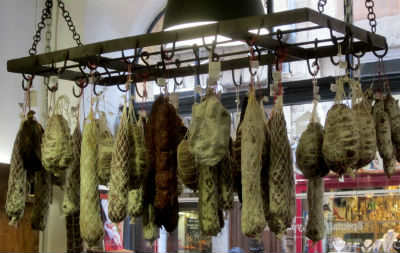 Day 6: my boat; Vieux Lyon; Gastronomie Lyonnaise; Since I arrived in France
I have had a uniform that may be looking familiar: a clean shirt, my
red-checked hoodie, my leather jacket, my grey hat. They have done great
work against wind, rain, chill. The only time I took off the jacket was at
the Mozart concert, #40 and Mozart Mass. (They were awesome except I went to
the Opera Hall instead of the "auditorium." I was a half hour early and with
guidance I took the bus and walked within 25 minutes. The transportation
system is also awesome. Is there hope for Saint Paul?)
Day 6: my boat; Vieux Lyon; Gastronomie Lyonnaise; Since I arrived in France
I have had a uniform that may be looking familiar: a clean shirt, my
red-checked hoodie, my leather jacket, my grey hat. They have done great
work against wind, rain, chill. The only time I took off the jacket was at
the Mozart concert, #40 and Mozart Mass. (They were awesome except I went to
the Opera Hall instead of the "auditorium." I was a half hour early and with
guidance I took the bus and walked within 25 minutes. The transportation
system is also awesome. Is there hope for Saint Paul?)

Day 7: Roman antiquity; Easter churches; Another Bouchon; museums: The sun shone today but did not erase the chill. It is Easter and my path took me into several Catholic services. Into "Old Lyon" I took the funicular up to the Roman amphitheater and its stunning museum. It has the most impressive mosaics I have ever seen. Then to another bouchon, but only three courses today! Then the museum of movie artifacts (!) and miniatures and a "Guignol" museum--Lyon's famous puppet. Now an evening to read (Girl With a Pearl Earring) and rest.
 Day 8: From creation to eternity: First, The Parc de la Tête d'Or along the
Rhône River is a botanical garden, zoo, and was conceived as an English
Garden of 16 hectares with a lake the size of Lake Como. Then I was off to
the Musée des Confluences where the Rhône and Saône Rivers come together. It
is like a natural history museum and would drive conservatives crazy since
the introduction was about how the 19th Century thoughts on creationism hves
been displaced by science. A permanent exhibit displays the science of how
the universe
Day 8: From creation to eternity: First, The Parc de la Tête d'Or along the
Rhône River is a botanical garden, zoo, and was conceived as an English
Garden of 16 hectares with a lake the size of Lake Como. Then I was off to
the Musée des Confluences where the Rhône and Saône Rivers come together. It
is like a natural history museum and would drive conservatives crazy since
the introduction was about how the 19th Century thoughts on creationism hves
been displaced by science. A permanent exhibit displays the science of how
the universe
began, how evolution took place, how humans emerged, and
how eternity is culturally interpreted, The second part of the museum is
dedicated to special exhibits including the treasures of Émile Guimet (1836
-1918), an industrialist and world explorer and collector. His passion was
to share what he learned with the common man and get it out of "scholarly
circles". The collection is vast, museum quality and and very culturally
diverse. Another indepth treatment was the conquest of the South Pole by
Roald Amundsen of Norway and Robert Falcon Scott of Britain. Amundsen was
first and Scott's team did not survive but made it.
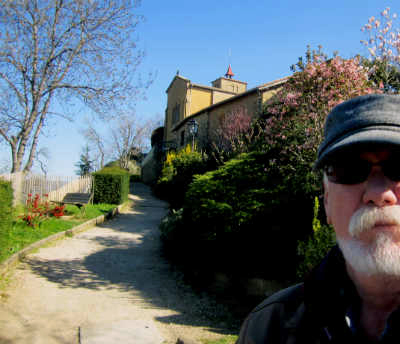 Day 9: Beaujolais villages and Peruges: This day trip featured the region of
Côte-d'Or, named after the golden color of the limestone of its buildings or
the color of vines in fall. It is also the only region of Bougelais wines.
Our guide Huibert drove the seven of us first to villages dating to the 12th
Century, and then to the vinyards of Vins Brost et Fils, au domain colline
de Chessy, four generations wine makers. We learned about Beaujolais Nouveau
(drink before 6 months), Beaujolais garde (up to eight years), a chardonnay,
and a sparkling variation. I learned about the difference in growing vines
(close rows cropped back to force roots deeper), types of soil, pest
control, pressing, etc. Surprisingly vineyards cannot irrigate/water! Then
we got to taste! Then we went to the 12th Century town of Peruges (there's a
city in Italy by the same name) where all the buildings and wall
fortifications are made of stones from its river.
Day 9: Beaujolais villages and Peruges: This day trip featured the region of
Côte-d'Or, named after the golden color of the limestone of its buildings or
the color of vines in fall. It is also the only region of Bougelais wines.
Our guide Huibert drove the seven of us first to villages dating to the 12th
Century, and then to the vinyards of Vins Brost et Fils, au domain colline
de Chessy, four generations wine makers. We learned about Beaujolais Nouveau
(drink before 6 months), Beaujolais garde (up to eight years), a chardonnay,
and a sparkling variation. I learned about the difference in growing vines
(close rows cropped back to force roots deeper), types of soil, pest
control, pressing, etc. Surprisingly vineyards cannot irrigate/water! Then
we got to taste! Then we went to the 12th Century town of Peruges (there's a
city in Italy by the same name) where all the buildings and wall
fortifications are made of stones from its river.
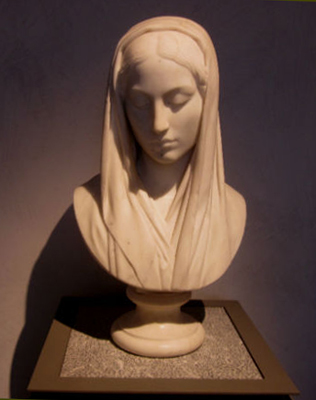 Day 10: Musée des Beaux-Arts (Fine Art Museum); Lyon history museum; Puppet
Museum: Here you'll see a not-so-eclectic series at the Musée des Beaux-Arts
(never flash!). Afterwards is was a short walk to the Gadagne Musées for the
history of Lyon and of puppets!
Day 10: Musée des Beaux-Arts (Fine Art Museum); Lyon history museum; Puppet
Museum: Here you'll see a not-so-eclectic series at the Musée des Beaux-Arts
(never flash!). Afterwards is was a short walk to the Gadagne Musées for the
history of Lyon and of puppets!
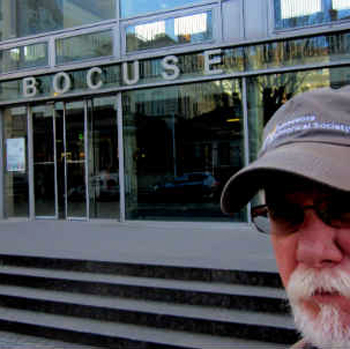 Day 11: dining and design: For my last day in Lyon and France I first went
to the "stomach" of Lyon: Les Halles de Lyon (of Paul Bocuse), a covered
market 60 "shops" featuring the best quality food products. Paul Bocuse is a
French chef based in Lyon, famous for his innovative approaches to cuisine
(nouvelle cuisine) including local fresh ingredients. Then with a tour of
the fabric museum (Lyon was famous for its weavers) and onto the Bocuse
restaurant "school" for a three-course meal (still fancy and pricey)! Then I
returned to the museum for decorative arts, and back to my boat for packing
for tomorrow's train.
Day 11: dining and design: For my last day in Lyon and France I first went
to the "stomach" of Lyon: Les Halles de Lyon (of Paul Bocuse), a covered
market 60 "shops" featuring the best quality food products. Paul Bocuse is a
French chef based in Lyon, famous for his innovative approaches to cuisine
(nouvelle cuisine) including local fresh ingredients. Then with a tour of
the fabric museum (Lyon was famous for its weavers) and onto the Bocuse
restaurant "school" for a three-course meal (still fancy and pricey)! Then I
returned to the museum for decorative arts, and back to my boat for packing
for tomorrow's train.
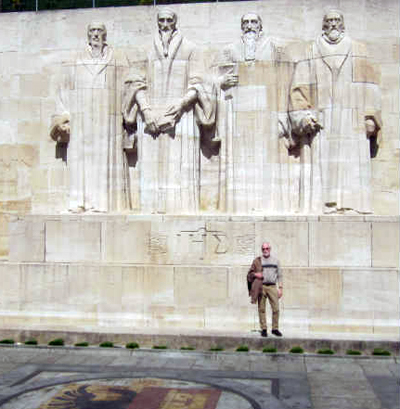 Day 12: Images of Geneva with Monique and her son
Day 12: Images of Geneva with Monique and her son
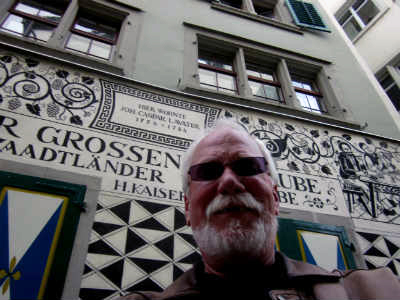 Day 13: Zurich, Switzerland
Day 13: Zurich, Switzerland
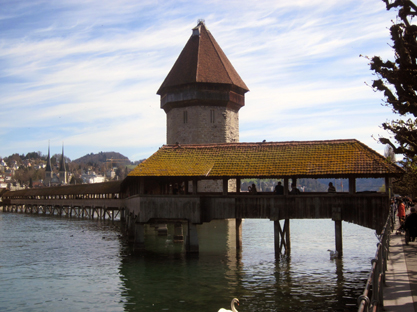 Day 14: The incredible Luzern/Lucerne with friends
Day 14: The incredible Luzern/Lucerne with friends
Day 15: Milan's Design Week--streets of one of the world's great cities: the train from Les Paccots/Montreux to Milan presented spectacular views of mountains and Lake Maggiore/Lago Verbano. Would love to explore the latter with its little island villages. Milan's train station is huge and impressive! After getting situated in my apartment, and exploring how to find it, I made my way to the piazza of the Duomo (cathedral) di Milano--a site that takes your breath away. The other highlight was the Museo del Novocentao--that features 20th Century (Italian) art. It had probably the most in depth explanation of art's movement through that century.
Day 16: Sister Kaye and Milan: Kaye arrived from the US to join my adventure in Milan. Since the bus from the airport was close, we visited the plaza of the Duomo, had a drink at the Galleria Vittorio Emanuele II (one of the world's oldest shopping malls), and made our way to the apartment. After Kaye rested a bit, out we went to buy tickets to the ballet Giselle at La Scala (Thursday), and saw a creative kaleidoscope of color-light (to every light a voice) in a darkened "tent" by Ford for Design Week. Also stopped in at a design display in the Galleria for a taste of design of what was to come.
Day 17: Salone del Mobile/Milan's Design Week: Imagine the creativity over-load wandering 200,000 sq meters/2.2 million (!) sq ft with 2,000 exhibitors worldwide showing the best of their design and new products. It lasts a week and I registered as a "Trade Operator" for one day... If you go, two days; public only the last two days. We were glad to have started where we did (lighting/design) and skipped workplace stuff. Toward the end I had enough of overstuffed stuff and amazingly costly furniture and accessories, including chandeliers as big as my living room. No, bigger.
Day 18: Castle museum(s), peace park, monumental cemetery: Giselle: I put my sister Kaye through her paces today. We started out at Castello Sforzesco: a 15th century citadel, one of the largest in Europe and home to a whole series of museums: ancient art, medieval and Renaissance paintings, Egyptian, ceramics, et al. Then we walked through a park to the Porta Sempione ("Simplon Gate"). The gate is marked by a landmark triumphal arch called Arco della Pace ("Arch of Peace"), dating back to the 19th century, but its origins can be traced back to a gate of the Roman walls of Milan. Then we crossed through Chinatown to the Monumental Cemetery! All on foot. The Cimitero Monumentale di Milano was established in 1866 and has a number of artistic and dramatic tombs and monuments. The cemetery resembles an outdoor sculpture garden. It is entered through the Famedio, a massive Hall of Fame-like Neo-Medieval style building made of marble and stone that contains the tombs of some of the city's and the country's most honored citizens, including that of novelist Alessandro Manzoni "Famedio," part memorial chapel and part mausoleum for famous graves. After an afternoon rest (and bath!) off to the ballet Giselle at La Scalla followed by dinner at our local art bar (music; tangos) and home at midnight.
Day 19: Neighborhood and Roman history in the rain: what else to do but explore local(ly)? First off, our neighborhood of Sant' Ambrogio is quite hip and historic, named after one of the most ancient churches in Milan and built by St. Ambrose in 379-386, in an area where numerous martyrs of the Roman persecutions had been buried. The first name of the church was in fact Basilica Martyrum and the current Romanesque church was renovated around 1080. Little did we know that the historic courtyard featured "Flora Decora", filled with "flowers, plants, and decoration". Then down the street Via Edmundo De Amicis we visited the site of Milan's Roman amphitheater ruins. Milan's origins go back to early Iron Age, and the city off "Mediolanum" eventually included Roman citizenship in 49 BCE (Before the Christian Era). It became the capital of the Western Roman Empire in 286 AD. Just a short walk after, and we stumbled upon the Church of St. Laurence the Greater (S. Lorenzo Maggiore) and its colonnaded courtyard, originally built in Roman times and subsequently rebuilt several times over a number of centuries. Next up a beautiful door of another church, then back to our art bar "biciclette" for happy hour where the staff is getting to know us.
Day 20: in search of: The day began strangely as we could not find the flea market or its canal. Google Maps was off--but when found there were only clothes and food stalls--no treasures. Plan B--return to Duomo, go to Da Vince exhibit that was wonderful except all in Italian with English audio. Latter was OK except all the stations' audio played in the room and you could not decipher anything. Decipher: good word for Da Vinci's brilliance. Then onto search for an antique mall without benefits and a particular fabric shop for Kaye that was elusive. Then we discovered a street that continued "Design Week" theme--interrupted by a storm that got us soaked. To be continued...
Day 21: Mass, University, Design Week: After mass at the local church (Sant'Ambrogio) we wandered courtyards of the Catholic University and headed home for coffee and pastries. Then out to again explore Design Week and In Brera Pinacoteca-the art museum. The latter is stunning, a 14th Century building filled mostly with Old Master paintings dating from when Napoleon closed monasteries and churches and took their art. Then what a treat: the Brera Design District was filled with outdoor tables filled with tempting objets. Then pizza with traditional salami and red wine
